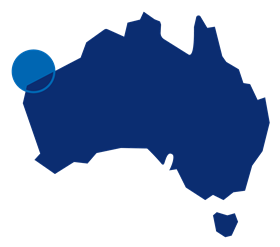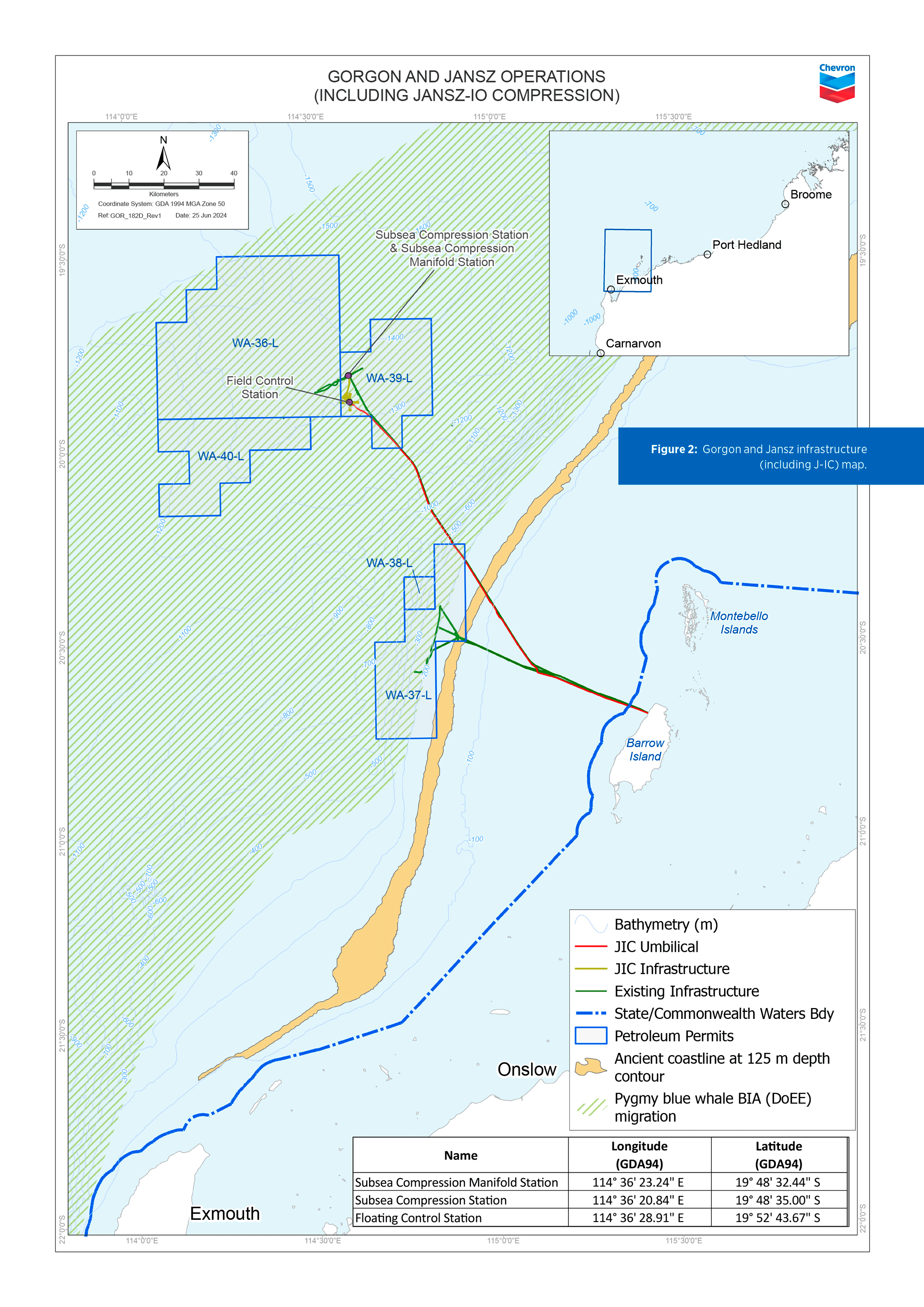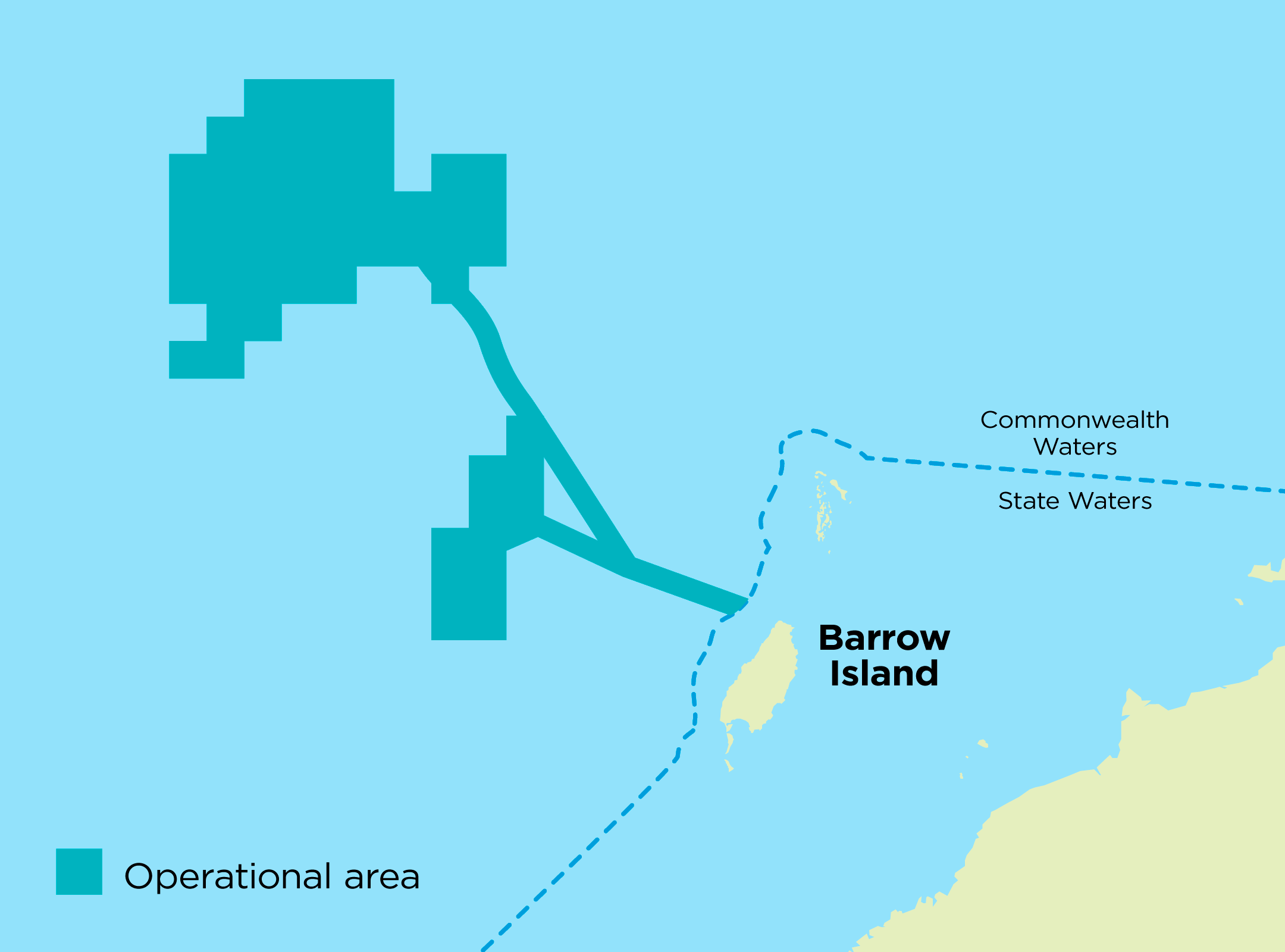activity information
gorgon gas development gorgon and jansz feed gas pipeline and wells operations
(including jansz-io compression)
Chevron Australia, on behalf of the Gorgon Joint Venture, operates the Gorgon Project located off the northwest coast of Western Australia (WA).
Since 2015, offshore production wells and pipeline infrastructure have gathered natural gas from the Jansz-Io and Gorgon gas fields and transported it to the Gorgon Gas Facility on Barrow Island. From the Gorgon Gas Facility, gas is processed for export as liquefied natural gas (LNG) or piped to the mainland for WA domestic gas users.
As predicted, the Jansz-Io gas field reservoir pressure has declined over time. To enhance the recoverability of gas and maintain current rates of production at the Gorgon Gas Facility, Chevron Australia plans to install and operate a subsea compression station (SCSt), floating field control station (FCS) and associated infrastructure [Table 1].
Installation of compression infrastructure in the Jansz-Io field was always contemplated as a means of maintaining current production levels over the approved life of the Gorgon development and will support the ongoing delivery of energy to customers in WA and the Asia Pacific region for decades to come.
Chevron Australia is currently undertaking a revision of the Gorgon Gas Development Gorgon and Jansz Feed Gas Pipeline and Wells Operations (Commonwealth Waters) Environment Plan (EP), to include the operation of the Jansz-Io Compression (J-IC) infrastructure.
A separate EP, which addresses J-IC installation activities was accepted by the National Offshore Petroleum Safety and Environmental Management Authority (NOPSEMA) in May 2024.
This information is intended to assist ‘relevant persons’ to make an informed assessment of the environmental impact and risks of our activities and to provide input and feedback to enhance the revision of the EP.
Relevant persons are those whose functions, interests or activities may be affected by our activities. This includes Traditional Owners and Custodians’ spiritual and cultural connection to Country, commercial and recreational fishing, tourism, individuals or groups in local communities.
Please note: in the context of an EP, each of the following is considered part of the ‘environment’:
- an ecosystem and their constituent parts, including people and communities
- natural and physical resources
- the qualities and characteristics of locations, places and areas
- the heritage value of places
- the social, economic and cultural features of the above.
location and water depth

The Jansz-Io gas field is located within production licences WA-36-L, WA-39-L and WA-40-L, approximately 200 kilometres (km) off the northwest coast of WA in water depths of approximately 1,350 metres (m). The Gorgon gas field is located within production licences WA-37-L and WA-38-L, approximately 130 km off the northwest coast of WA, and 65 km northwest of Barrow Island in water depths of approximately 200 m.
The Gorgon and Jansz pipelines are located in Commonwealth waters within pipeline licences WA-19-PL and WA-20-PL. The operational area (OA) in which the petroleum activities described in the EP will be undertaken is shown in Figure 1. The location of Gorgon Project infrastructure is shown in Table 1 (coordinates) and and Figure 2 (map).
activity summary
The revised EP will include the commissioning and start-up of the SCSt and ongoing operations of the new J-IC subsea and floating infrastructure [Table 1].
The FCS will be normally unattended, with personnel onboard during periodic inspection, maintenance and repair (IMR) campaigns. Personnel will be transferred to the FCS via helicopter or a support vessel. The SCSt will be operated and monitored remotely from a control room on Barrow Island.
The routine operation of the existing Gorgon and Jansz-Io hydrocarbon systems will continue under the revised EP. Primary activities include the flow and transportation of hydrocarbon and other produced fluids from the wells to the Gorgon Gas Facility on Barrow Island, via infield flowlines and pipelines. Periodic IMR activities will be undertaken to ensure the integrity of infrastructure is maintained.
IMR activities may include:
- visual inspections – may involve the use of remotely operated vehicles (ROVs) or similar and divers and a dive support vessel
- marine surveys
- testing and measurements
- pigging (e.g. cleaning) of pipelines
- module/component change-out, stabilisation, removal of marine growth etc.
During normal operations, vessels will typically be limited to supply/support vessels and IMR vessels. The vessel size and type will be dependent on the work scope. It is anticipated vessels will operate 24 hours per day for the duration of activities.
schedule and duration
The revised EP will cover the ongoing operation of the hydrocarbon system (production wells, pipelines, and associated infrastructure) in Commonwealth waters for the Gorgon and Jansz-Io gas fields.
IMR activities may occur at any time, with the frequency determined using a broad risk-based approach, which will include an assessment of safety, environmental and commercial risks. The duration will depend on the scope of the activities, however works will typically be completed within 10 to 200 days.
Subject to relevant approvals and other factors, J-IC operational activities, including commissioning and start-up, were expected to commence from 2026.
As of December 2024, the indicative schedule for the J-IC Project has been updated, with commissioning activities expected to commence from 2026, and start-up and operational activities expected from 2027 or 2028.
environment that may be affected (EMBA)
As part of our environmental assessment and consultation process, we create an EMBA map to provide geographical context for stakeholders to determine if their functions, interests or activities may be affected by an offshore activity during operations or in an emergency scenario.
Figure 1 shows the EMBA, which is based on a worst-case environmental scenario, which in this case is an unplanned release (oil spill) from the hydrocarbon system and/or a vessel collision. Shoreline loading refers to areas of the coast that may be impacted by hydrocarbons.
The EMBA has been defined through combining 300 simulations for each unplanned release scenario under different weather and ocean conditions. This means that in the highly unlikely event an unplanned release does occur, a geographical area much smaller than the EMBA would be affected.
The majority of the impacts or risks directly arising from activities, or from an emergency scenario, would occur within close proximity of the OA.
Chevron Australia has systematic control measures to prevent and mitigate emergencies and to reduce the impact of planned activities on the environment, including ecological, social and cultural sensitivities.
Table 2 summarises the key impacts or risks and proposed control measures to manage these to levels that are as low as reasonably practicable (ALARP) and acceptable.
safe navigation area and marine exclusion zone
The following infrastructure is subject to a 500 m radius petroleum safety exclusion zone:
- Gorgon midline pipeline termination structure
- Gorgon M1 – production manifold and wells
- Gorgon M2 – production manifold and wells
- Gorgon M3 – production manifold and wells
- Gorgon M4 – production manifold and wells
- Jansz umbilical midline connection assembly
A new 500 m radius exclusion zone will be sought for the FCS once installed.
No other exclusion zones will be sought for the subsea infrastructure.
marine fauna and biologically important areas (BIAs)
Chevron Australia has undertaken extensive environmental and modelling studies and considered scientific advice and government guidance (including conservation management and recovery plans) in assessing impacts and risks to marine fauna.
The SCSt will be situated at a water depth of ~1,350 m on the seabed, where operations will result in a localised change to ambient underwater sound.
Marine fauna found at the SCSt location are predominantly pelagic and deep-sea demersal fish species. Some threatened and/or migratory fish species (e.g. whale sharks, other sharks and manta rays) may be present in the area; however, these are primarily coastal species or are associated with shallower water or features (e.g. seamounts and reefs).
Biologically Important Areas (BIAs) for several marine fauna species overlap the EMBA. Additionally, the pygmy blue whale migration BIA overlaps with the SCSt location [Figure 2].
As with most offshore areas in WA, a range of other marine mammal species are known to transit the J-IC area including Antarctic minke whales, Bryde’s whales, fin whales, humpback whales, sei whales, sperm whales, killer whales and spotted bottlenose dolphins.
The closest turtle nesting habitats to J-IC are Barrow, Montebello, and Lowendal islands, over 135 km away. Similarly, shallower internesting BIAs extend a maximum of 60 km from these nesting beaches, more than 70 km from the SCSt and FCS.
first nations cultural values
We acknowledge that Traditional Owner groups in the northwest region of WA have identified Sea Country as an important value and expressed a deep obligation to protect songlines, dreaming stories and the marine fauna connected to them.
Chevron Australia is committed to ongoing engagement and consultation with Traditional Owners and their representative bodies. This process will continue to inform our understanding of cultural values and features and help facilitate the co-design of appropriate controls to avoid impacts.
approvals process
Petroleum activities in Commonwealth waters are regulated by NOPSEMA. Before petroleum activities can take place, Chevron Australia must develop an EP which will be assessed by NOPSEMA in accordance with the requirements of the Offshore Petroleum and Greenhouse Gas Storage (Environment) Regulations 2023 (the Regulations).
The Regulations require us to consult with relevant persons whose functions, interests and activities may be affected by the petroleum activity.
Following consultation, we will submit to NOPSEMA a revised version of the Gorgon Gas Development Gorgon and Jansz Feed Gas Pipeline and Wells Operations EP, which will:
- describe the environment in which operations, including the operation of the J-IC infrastructure, are planned to take place;
- include an assessment of environmental impacts and risks arising from those operations;
- identify control measures to manage the potential impacts and risks to levels that are acceptable and ALARP; and
- outline how Chevron Australia has engaged with relevant persons and how their feedback has been considered and addressed.
NOPSEMA will assess whether the EP satisfies the Regulations, including whether the environmental impacts and risks of operations will be managed so that they are acceptable and ALARP before accepting the EP.
your input
We are now seeking your feedback and input if you consider your functions, interests, or activities may be affected based on the information provided, including the summary of the key environmental impacts and risks identified to date in Table 2.
We encourage you to provide additional details about the environment, aspects, consequences of the activity or control measures or to ask for further information or consultation by Monday 17 February 2025.
Relevant persons may request that the information they provide be treated as confidential. Chevron Australia will make this known to NOPSEMA and it will be identified as sensitive information and not published in the EP.
You can contact us with any questions, requests for information, or feedback by calling tollfree on 1800 225 195 or online below.
what's next
The feedback we receive during consultation will be used to inform and enhance the EP before it is submitted to NOPSEMA for assessment.
We commit to keeping you informed and providing responses to any relevant person who so requests.
privacy notice
If you choose to provide feedback, Chevron Australia will collect your name and contact details, for the purposes of maintaining contact with you and including your feedback in our submission to NOPSEMA. Provision of this information is purely voluntary, however if you choose not to provide it, we may not be able to contact you in the future. Chevron may transfer your information to NOPSEMA if required and, if you do not identify it as sensitive, to other Chevron affiliates including our head office in the United States.
For further information regarding how we protect your personal information, and your rights, please refer to our privacy notice.
further information

Figure 1. Gorgon and Jansz Operations (including J-IC) EMBA map.

Figure 2. Gorgon and Jansz infrastructure (including J-IC) map.
Table 1: Gorgon Project Infrastructure Details – view table 1 here.
Table 2: Summary of key impacts and risks and key proposed control measures for operational activities – view table 2 here.
information sheets
Jansz-Io Compression underwater sound information sheet > PDF
resources
- Consultation on Offshore Petroleum Environment Plans – NOPSEMA pdf opens in new window
- Consultation in the course of preparing an environment plan – NOPSEMA pdf opens in new window
- Environment plan content requirements – NOPSEMA pdf opens in new window
- Environmental requirements – NOPSEMA opens in new window
- Offshore Petroleum and Greenhouse Gas Storage (Environment) Regulations opens in new window
- NOPSEMA Assessment Process Environment Plans opens in new window
- Chevron Operational Excellence Management System (OEMS) opens in new window
- Jansz-Io Compression underwater sound information sheet pdf opens in new window
- Gorgon and Jansz feed gas pipeline and wells operations (including jansz-io compression) information sheet pdf opens in new window
